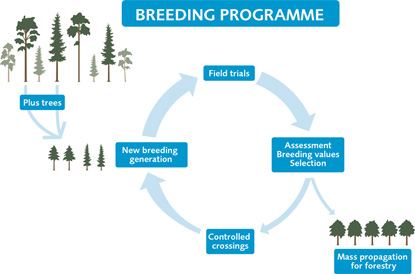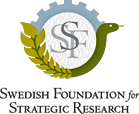Contact
jan.stenlid@slu.se, 018-671807
This project centres on the root rot fungus Heterobasidion annosum s.l., a major pathogen of forest trees causing approx 1 billion SEK losses annually to forestry in Sweden, and its interactions with the hosts Norway spruce and Scots pine.
The overall aim is to understand the processes involved with the ultimate goal of finding ways to controlling the disease. Applying genetic and genomic approaches will ensure identification of relevant genes both from the host and the fungal pathogen. By including forest breeders in the research team we aim at implementing resistance characters in practical forestry.

Left: Markers of necrotic cell death in Norway spruce embryogenic cultures FM-64/FDA staining (Photo: Alyona Minina) Middle: Rotted spruce logs (Photo: Jan Stenlid) Right: GFP transformed H. occidentale (Photo: Heriberto Velez).
Fungal pathogenicity will be studied by QTL maps and information from the sequenced H. irregulare genome. Candidate genes will be identified from bioinformatics, transcript profiling, and from mapped QTLs of pathogenicity. Functional studies will be performed by gene silencing and overexpression using established technology for transformation. In Norway spruce resistance reaction will be studied using transcript profiling, and experiments establishing the role of programmed cell death and fungal toxins. A genetic linkage map in spruce will be worked out and QTL analysis will also be performed. Previous work has shown resistance towards root rot in Norway spruce to be an inheritable trait. We will identify genetic markers correlated with resistance, confirm the practical resistance trials and develop clonal lines for use in practical forestry and for seed orchards.
SkogForsk (The Forest Research Institute of Sweden) is responsible for the genetic improvement of the major forest tree species for Swedish forests. The breeding principles are simple. Progress is based on repeated series of testing selection and controlled crosses. Each breeding generation takes between 20‐25 years due to Norway spruce’s generation time.

Graphic representation of the Swedish breeding programmes (Image from SkogForsk).
The most important traits for breeding are tree vitality, wood production and stem quality. Wood and fiber quality and resistance to pathogens will be increasingly important. The results from this project will facilitate the selection of material with high breeding value for pathogen resistance.
This project is financed by SSF

jan.stenlid@slu.se, 018-671807